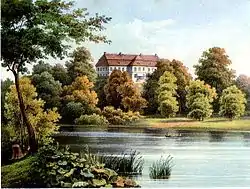Dzikowo Iławeckie | |
|---|---|
Village | |
 Wildenhoff Palace (destroyed in 1945) | |
 Dzikowo Iławeckie | |
| Coordinates: 54°19′49″N 20°24′24″E / 54.33028°N 20.40667°E | |
| Country | |
| Voivodeship | Warmian-Masurian |
| County | Bartoszyce |
| Gmina | Górowo Iławeckie |
| Population | 290 |
Dzikowo Iławeckie [d͡ʑiˈkɔvɔ iwaˈvɛt͡skʲɛ] (German: Wildenhoff) is a village in the administrative district of Gmina Górowo Iławeckie, within Bartoszyce County, Warmian-Masurian Voivodeship, in northern Poland, close to the border with the Kaliningrad Oblast of Russia.[1] It lies approximately 9 kilometres (6 mi) north-west of Górowo Iławeckie, 28 km (17 mi) west of Bartoszyce, and 61 km (38 mi) north of the regional capital Olsztyn.
History
In 1491 the Teutonic Order awarded the Old Prussian settlement of Ampunden, sized 12 "Hufen",a square measure of the Teutonic Knights, to the nobleman Paul Pregel and after the abolition of the Monastic state of the Teutonic Knights Ampunden was awarded to the former Teutonic Knight Friedrich Truchseß von Waldburg by Duke Albert of Prussia in 1535. The name Ampunden was soon changed to Wildenhoff, which became the parent house of the Waldburg family. After the death of Gebhard Truchseß von Waldburg his wife married Otto von Schwerin in 1656, constituting the von Schwerin-Wildenhoff family, owner of the manor of Wildenhoff and advowson of the Church of Landsberg until 1945. In 1705 a large baroque palace was built by Friedrich Wilhelm Graf von Schwerin, which was completely destroyed in 1945.[2]
In autumn 1944 several works of art from museums of Königsberg were evacuated to Wildenhoff,[3] rumours also claimed the famous Amber Room might have been part of these pieces. In fact the head of the Königsberg museums administration, Dr. Alfred Rohde, visited Wildenhoff in October 1944 and organized several transports, excavations made in 1960 delivered some remains of different pieces of art, but no indications of the Amber Room theory.[4]
After World War II the town again became part of Poland, under territorial changes demanded by the Soviet Union at the Potsdam Conference.
Population
- 1933: 367
- 1939: 334[5]
- 2008: 290
References
- ↑ "Central Statistical Office (GUS) - TERYT (National Register of Territorial Land Apportionment Journal)" (in Polish). 2008-06-01.
- ↑ Horst Schulz, Der Kreis Preußisch Eylau, Verden 1983 (German)
- ↑ Esther Grafin Schwerin, "Kormorane, Brombeerranken" (German) ISBN 3-548-22107-6
- ↑ amberroom.org
- ↑ verwaltungsgeschichte.de
External links
- Wildenhoff Palace (in German)